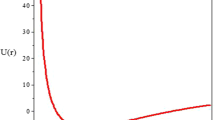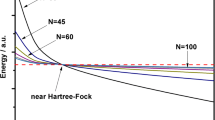Abstract
Pseudospectral methods based on non-classical quadratures are used to numerically compute the eigenvalues and eigenfunctions of the Schrödinger equation for the Rosen-Morse and Eckart potentials. The method uses a basis set of non-classical polynomials, \(\{ P_n(x) \}\), orthonormal with respect to a weight function, \(w(x)>0\), to construct an \(N \times N\) matrix representative, \(\{ H_{nm} \}\), of the Hamiltonian, H. This matrix representative is transformed to an equivalent pseudospectral representative, \(\{H_{ij}\}\). The rate of convergence of the eigenvalues of \(\{ H_{ij} \}\) to the eigenvalues of H, versus the grid size N, is reported for non-classical basis functions in comparison with the use of Legendre and Laguerre polynomials as well as a Fourier basis. The use of non-classical polynomials is shown to provide the fastest convergence for the eigenvalues. The pseudospectral method based on nonclassical quadratures proposed in this paper should find wide applicability to other problems in quantum and statistical mechanics. A review is provided of the use of a tensor product of one dimensional basis functions to describe two and three dimensional problems.







Similar content being viewed by others
References
B.D. Shizgal, H. Chen, The quadrature discretization method (QDM) in the solution of the Schrödinger equation with nonclassical basis functions. J. Chem. Phys. 104, 4137–4150 (1996)
B.D. Shizgal, H. Chen, The quadrature discretization method in the solution of the Fokker–Planck equation with nonclassical basis functions. J. Chem. Phys. 107, 8051–8063 (1997)
D. Baye, P.H. Heenen, Generalized meshes for quantum-mechanical problems. J. Phys. A Math. Gen. 19, 2041–2059 (1986)
D. Baye, M. Hesse, M. Vincke, The unexplained accuracy of the Lagrange-mesh method. Phys. Rev. E 65, 026701 (2002)
D.T. Colbert, W.H. Miller, A novel discrete variable representation for quantum-mechanical reactive scattering via the S-Matrix Kohn method. J. Chem. Phys. 96, 1982–1991 (1992)
J.C. Light, T. Carrington Jr., Discrete variable representations and their utilization. Adv. Chem. Phys. 114, 263–310 (2000)
V. Szalay, Optimal grids for generalized finite basis and discrete variable representations: definition and method of calculation. J. Chem. Phys. 125, 154115 (2006)
V. Szalay, G. Czako, A. Nagy, T. Furtenbacher, A.G. Csaszar, On one-dimensional discrete variable representations with general basis functions. J. Chem. Phys. 119, 10512–10518 (2003)
D. Kosloff, R. Kosloff, A Fourier method of solution for the time-dependent Schrödinger-equation as a tool in molecular dynamics. J. Comput. Phys. 52, 35–53 (1983)
R. Kosloff, The Fourier method, in Numerical Grid Methods and their Application to Schrödinger’s Equation, ed. by C. Cerjan (Kluwer Academic, Dordrecht, 1993), pp. 175–194
C.C. Marston, G.G. Balint-Kurti, The Fourier grid Hamiltonian method for bound state eigenvalues and eigenfunctions. J. Chem. Phys. 91, 3571–3576 (1989)
J. Stare, G.G. Balint-Kurti, The Fourier grid Hamiltonian method for solving the vibrational Schrödinger equation in internal coordinates: theory and test applications. J. Phys. Chem. A 107, 7204–7214 (2003)
A. Derevianko, E. Luc-Koenig, F. Masnou-Seeuws, Application of B-splines in determining the eigenspectrum of diatomic molecules: robust numerical description of halo-state and Feshbach molecules. Can. J. Phys. 87, 67–74 (2009)
B.W. Shore, Solving the radial Schrödinger equation by using cubic-spline basis functions. J. Chem. Phys. 58, 3855–3866 (1973)
F. Cooper, A. Kharem, U. Sukhatme, Supersymmetry and quantum mechanics. Phys. Rep. 251, 267–385 (1995)
F. Cooper, J.N. Ginocchio, A. Khare, Relationship between supersymmetry and solvable potentials. Phys. Rev. D 36, 2458–2473 (1987)
C.-L. Ho, Simple unified derivation and solution of Coulomb, Eckart and Rosen-Morse potentials in prepotential approach. Ann. Phys. 324, 1095–1104 (2009)
S. Dominguez-Hernandez, D.J. Fernandez, C. Rosen-Morse, Potential and its supersummetric partners. Int. J. Theor. Phys. 50, 1993–2001 (2011)
G.-H. Sun, S.H. Dong, Quantum information entropies of the eigenstates for a symmetrically trigonometric Rosen-Morse potential. Phys. Scr. 87, 045003 (2013)
G.-H. Sun, S.H. Dong, Quantum information entropies for an asymmetric trigonometric Rosen-Morse potential. Ann. Phys. 525, 934–943 (2013)
S.A. Najafizade, H. Hassanabadi, D. Zarrinkamar, Information theoretic global measures of Dirac Equation with Morse and trigonometric Rosen-Morse potentials. Few Body Syst. 68, 149–163 (2017)
R. Dutt, A. Khare, U.P. Sukhatme, Supersymmetry, shape invariance, and exactly solvabe potentials. Am. J. Phys. 56, 163–168 (1987)
R.K. Yadav, A. Khare, B.P. Mandal, The scattering amplitude for rationally extended shape invariant Eckart potentials. Phys. Lett. A 379, 67–70 (2015)
C. Quesne, Novel enlarged shape invariance property and eckartly solvable rational extensions of the Rosen-Morse II and Eckart potentials. SIGMA 8, 80–99 (2012)
H. Hassanabadi, B.H. Yazarloo, A.N. Ikot, N. Salehi, S. Zarrinkamr, Exact analytical versus numerical solutions of the Schrödinger equation for Hua plus modified Eckart potential. Indian J. Phys. 87(12), 1219–1223 (2013)
B.D. Shizgal, Pseudospectral method of solution of the Schrödinger equation with non-classical polynomials; the Morse and Poschl-Teller (SUSY) potentials. Comput. Theor. Chem. 1084, 51–58 (2016)
B.D. Shizgal, Pseudospectral solution of the Fokker–Planck equation with equilibrium bistable states: the eigenvalue spectrum and the approach to equilibrium. J. Stat. Phys. 164, 1379–1393 (2016)
B.D. Shizgal, A comparison of pseudospectral methods for the solution of the Schrödinger equation: the Lennard-Jones \((n,6)\) potential. Comput. Theor. Chem. 114, 25–32 (2017)
B. Shizgal, Spectral Methods in Chemistry and Physics: Applications to Kinetic Theory and Quantum Mechanics (Springer, New York, 2015)
W. Gautschi, On generating orthogonal polynomials. SIAM J. Sci. Stat. Comput. 3, 289–317 (1982)
W. Gautschi, Algorithm 726: ORTHOPOL—a package of routines for generating orthogonal polynomials with Gauss-type quadrature rules. ACM Trans. Math. Softw. 20, 21–82 (1994)
W. Gautschi, Orthogonal Polynomials in MATLAB: Excercies and Solutions (SIAM, Philadelphia, 2016)
J.Q.W. Lo, B.D. Shizgal, Pseudospectral methods of solution of the Schrödinger equation. J. Math. Chem. 44, 787–801 (2008)
B.D. Shizgal, N. Ho, X. Yang, The computation of radial integrals with nonclassical quadratures for quantum chemistry and other applications. J. Math. Chem. 55, 413–422 (2017)
K. Leung, B.D. Shizgal, H. Chen, The quadrature discretization method (QDM) in comparison with other numerical methods of solution of the Fokker–Planck equation for electron thermalization. J. Math. Chem. 24, 291–319 (1998)
C.-I. Gheorghiu, Laguerre collocation solutions to boundary layer type problems. Numer. Algorithm 64, 385–401 (2013)
B.D. Shizgal, H. Chen, The quadrature discretization method (QDM) in the solution of the Schrödinger equation with nonclassical basis functions. J. Chem. Phys. 104, 4137–4150 (1996)
H. Chen, Y. Su, B.D. Shizgal, A direct spectral collocation poisson solver in polar and cylindrical coordinates. J. Comput. Phys. 160, 453–469 (2000)
H.H. Yang, B.D. Shizgal, Chebyshev pseudospectral multi-domain technique for viscous flow calculation. Comput. Methods Appl. Mech. Eng. 118, 47–61 (1994)
L. Gibelli, B.D. Shizgal, A.W. Yau, Ion energization by wave–particle interactions: comparison of spectral and particle simulation solutions of the Vlasov equation. Comput. Math. Appl. 59, 2566–2581 (2010)
D. Bǵué, N. Gohaud, C. Pouchan, P. Cassam-Chenaï, J. Lie\(\acute{\text{v}}\)in, A comparison of two methods for selecting vibrational configuration interaction spaces on a heptatomic system: ethylene oxide. J. Chem. Phys. 127, 164115 (2007)
G. Avila, T. Carrington Jr., Reducing the cost of using collocation to compute vibrational energy levels: results for \(\text{ CH }_2\)NH. J. Chem. Phys. 147, 064103 (2017)
Acknowledgements
This research was supported by a grant to Bernard Shizgal from the Natural Sciences and Engineering Research Council of Canada (NSERC), Grant Number (03190). Conor Morrison was supported in part by an Undergraduate Student Research Award (USRA) from NSERC, Reference Number (527568). We would like to thank Lucas Philipp for helpful discussions throughout the course of the research.
Author information
Authors and Affiliations
Corresponding author
Additional information
Publisher's Note
Springer Nature remains neutral with regard to jurisdictional claims in published maps and institutional affiliations.
Rights and permissions
About this article
Cite this article
Morrison, C.L., Shizgal, B. Pseudospectral solution of the Schrödinger equation for the Rosen-Morse and Eckart potentials. J Math Chem 57, 1035–1052 (2019). https://doi.org/10.1007/s10910-019-01007-2
Received:
Accepted:
Published:
Issue Date:
DOI: https://doi.org/10.1007/s10910-019-01007-2




